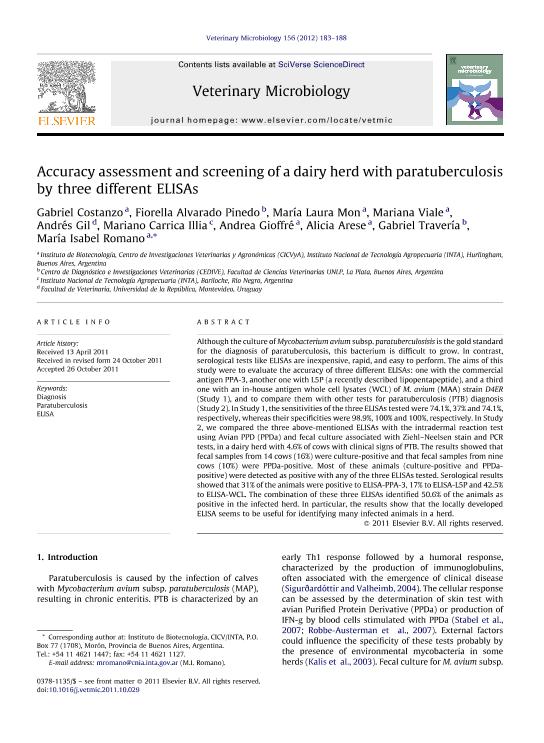Mostrar el registro sencillo del ítem
dc.contributor.author
Costanzo, Gabriel
dc.contributor.author
Alvarado Pinedo, María Fiorella

dc.contributor.author
Mon, Maria Laura

dc.contributor.author
Viale, Mariana Noelia

dc.contributor.author
Gil, Andres
dc.contributor.author
Carrica Illia, Mariano

dc.contributor.author
Gioffré, Andrea Karina

dc.contributor.author
Arese, Alicia
dc.contributor.author
Travería, Gabriel Eduardo

dc.contributor.author
Romano, Maria Isabel

dc.date.available
2023-04-26T13:22:20Z
dc.date.issued
2012-04
dc.identifier.citation
Costanzo, Gabriel; Alvarado Pinedo, María Fiorella; Mon, Maria Laura; Viale, Mariana Noelia; Gil, Andres; et al.; Accuracy assessment and screening of a dairy herd with paratuberculosis by three different ELISAs; Elsevier Science; Veterinary Microbiology; 156; 1-2; 4-2012; 183-188
dc.identifier.issn
0378-1135
dc.identifier.uri
http://hdl.handle.net/11336/195394
dc.description.abstract
Although the culture of Mycobacterium avium subsp. paratuberculosisis is the gold standard for the diagnosis of paratuberculosis, this bacterium is difficult to grow. In contrast, serological tests like ELISAs are inexpensive, rapid, and easy to perform. The aims of this study were to evaluate the accuracy of three different ELISAs: one with the commercial antigen PPA-3, another one with L5P (a recently described lipopentapeptide), and a third one with an in-house antigen whole cell lysates (WCL) of M. avium (MAA) strain D4ER (Study 1), and to compare them with other tests for paratuberculosis (PTB) diagnosis (Study 2). In Study 1, the sensitivities of the three ELISAs tested were 74.1%, 37% and 74.1%, respectively, whereas their specificities were 98.9%, 100% and 100%, respectively. In Study 2, we compared the three above-mentioned ELISAs with the intradermal reaction test using Avian PPD (PPDa) and fecal culture associated with Ziehl-Neelsen stain and PCR tests, in a dairy herd with 4.6% of cows with clinical signs of PTB. The results showed that fecal samples from 14 cows (16%) were culture-positive and that fecal samples from nine cows (10%) were PPDa-positive. Most of these animals (culture-positive and PPDa-positive) were detected as positive with any of the three ELISAs tested. Serological results showed that 31% of the animals were positive to ELISA-PPA-3, 17% to ELISA-L5P and 42.5% to ELISA-WCL. The combination of these three ELISAs identified 50.6% of the animals as positive in the infected herd. In particular, the results show that the locally developed ELISA seems to be useful for identifying many infected animals in a herd.
dc.format
application/pdf
dc.language.iso
eng
dc.publisher
Elsevier Science

dc.rights
info:eu-repo/semantics/openAccess
dc.rights.uri
https://creativecommons.org/licenses/by-nc-sa/2.5/ar/
dc.subject
DIAGNOSIS
dc.subject
ELISA
dc.subject
PARATUBERCULOSIS
dc.subject.classification
Otras Ciencias Veterinarias

dc.subject.classification
Ciencias Veterinarias

dc.subject.classification
CIENCIAS AGRÍCOLAS

dc.title
Accuracy assessment and screening of a dairy herd with paratuberculosis by three different ELISAs
dc.type
info:eu-repo/semantics/article
dc.type
info:ar-repo/semantics/artículo
dc.type
info:eu-repo/semantics/publishedVersion
dc.date.updated
2023-04-26T10:44:59Z
dc.journal.volume
156
dc.journal.number
1-2
dc.journal.pagination
183-188
dc.journal.pais
Países Bajos

dc.journal.ciudad
Amsterdam
dc.description.fil
Fil: Costanzo, Gabriel. Instituto Nacional de Tecnología Agropecuaria. Centro de Investigación en Ciencias Veterinarias y Agronómicas. Instituto de Biotecnología; Argentina
dc.description.fil
Fil: Alvarado Pinedo, María Fiorella. Universidad Nacional de La Plata. Facultad de Ciencias Veterinarias. Departamento de Clínica. Centro de Diagnóstico e Investigaciones Veterinarias; Argentina
dc.description.fil
Fil: Mon, Maria Laura. Consejo Nacional de Investigaciones Científicas y Técnicas; Argentina. Instituto Nacional de Tecnología Agropecuaria. Centro de Investigación en Ciencias Veterinarias y Agronómicas. Instituto de Biotecnología; Argentina
dc.description.fil
Fil: Viale, Mariana Noelia. Consejo Nacional de Investigaciones Científicas y Técnicas; Argentina. Instituto Nacional de Tecnología Agropecuaria. Centro de Investigación en Ciencias Veterinarias y Agronómicas. Instituto de Biotecnología; Argentina
dc.description.fil
Fil: Gil, Andres. Universidad de la Republica. Facultad de Veterinaria.; Uruguay
dc.description.fil
Fil: Carrica Illia, Mariano. Instituto Nacional de Tecnología Agropecuaria; Argentina
dc.description.fil
Fil: Gioffré, Andrea Karina. Consejo Nacional de Investigaciones Científicas y Técnicas; Argentina. Instituto Nacional de Tecnología Agropecuaria. Centro de Investigación en Ciencias Veterinarias y Agronómicas. Instituto de Biotecnología; Argentina
dc.description.fil
Fil: Arese, Alicia. Instituto Nacional de Tecnología Agropecuaria. Centro de Investigación en Ciencias Veterinarias y Agronómicas. Instituto de Biotecnología; Argentina
dc.description.fil
Fil: Travería, Gabriel Eduardo. Universidad Nacional de La Plata. Facultad de Ciencias Veterinarias. Departamento de Clínica. Centro de Diagnóstico e Investigaciones Veterinarias; Argentina
dc.description.fil
Fil: Romano, Maria Isabel. Consejo Nacional de Investigaciones Científicas y Técnicas; Argentina. Instituto Nacional de Tecnología Agropecuaria. Centro de Investigación en Ciencias Veterinarias y Agronómicas. Instituto de Biotecnología; Argentina
dc.journal.title
Veterinary Microbiology

dc.relation.alternativeid
info:eu-repo/semantics/altIdentifier/url/http://www.sciencedirect.com/science/article/pii/S0378113511005864
dc.relation.alternativeid
info:eu-repo/semantics/altIdentifier/doi/http://dx.doi.org/10.1016/j.vetmic.2011.10.029
Archivos asociados
